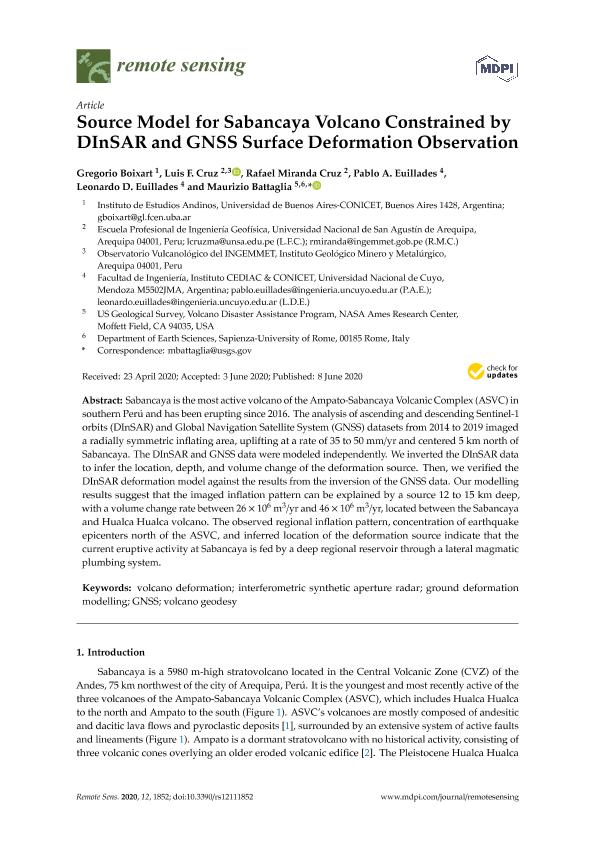Artículo
Source model for sabancaya volcano constrained by DInSAR and GNSS surface deformation observation
Boixart, Gregorio ; Cruz, Luis F.; Miranda Cruz, Rafael; Euillades, Pablo Andrés
; Cruz, Luis F.; Miranda Cruz, Rafael; Euillades, Pablo Andrés ; Euillades, Leonardo Daniel
; Euillades, Leonardo Daniel ; Battaglia, Maurizio
; Battaglia, Maurizio
 ; Cruz, Luis F.; Miranda Cruz, Rafael; Euillades, Pablo Andrés
; Cruz, Luis F.; Miranda Cruz, Rafael; Euillades, Pablo Andrés ; Euillades, Leonardo Daniel
; Euillades, Leonardo Daniel ; Battaglia, Maurizio
; Battaglia, Maurizio
Fecha de publicación:
06/2020
Editorial:
Molecular Diversity Preservation International
Revista:
Remote Sensing
ISSN:
2072-4292
Idioma:
Inglés
Tipo de recurso:
Artículo publicado
Clasificación temática:
Resumen
Sabancaya is the most active volcano of the Ampato-Sabancaya Volcanic Complex (ASVC) in southern Peru and has been erupting since 2016. The analysis of ascending and descending Sentinel-1 orbits (DInSAR) and Global Navigation Satellite System (GNSS) datasets from 2014 to 2019 imaged a radially symmetric inflating area, uplifting at a rate of 35 to 50 mm/yr and centered 5 km north of Sabancaya. The DInSAR and GNSS data were modeled independently. We inverted the DInSAR data to infer the location, depth, and volume change of the deformation source. Then, we verified the DInSAR deformation model against the results from the inversion of the GNSS data. Our modelling results suggest that the imaged inflation pattern can be explained by a source 12 to 15 km deep, with a volume change rate between 26 x 106 m3/yr and 46 x 106 m3/yr, located between the Sabancaya and Hualca Hualca volcano. The observed regional inflation pattern, concentration of earthquake epicenters north of the ASVC, and inferred location of the deformation source indicate that the current eruptive activity at Sabancaya is fed by a deep regional reservoir through a lateral magmatic plumbing system.
Archivos asociados
Licencia
Identificadores
Colecciones
Articulos(IDEAN)
Articulos de INSTITUTO DE ESTUDIOS ANDINOS "DON PABLO GROEBER"
Articulos de INSTITUTO DE ESTUDIOS ANDINOS "DON PABLO GROEBER"
Citación
Boixart, Gregorio; Cruz, Luis F.; Miranda Cruz, Rafael; Euillades, Pablo Andrés; Euillades, Leonardo Daniel; et al.; Source model for sabancaya volcano constrained by DInSAR and GNSS surface deformation observation; Molecular Diversity Preservation International; Remote Sensing; 12; 11; 6-2020; 1-11
Compartir
Altmétricas



